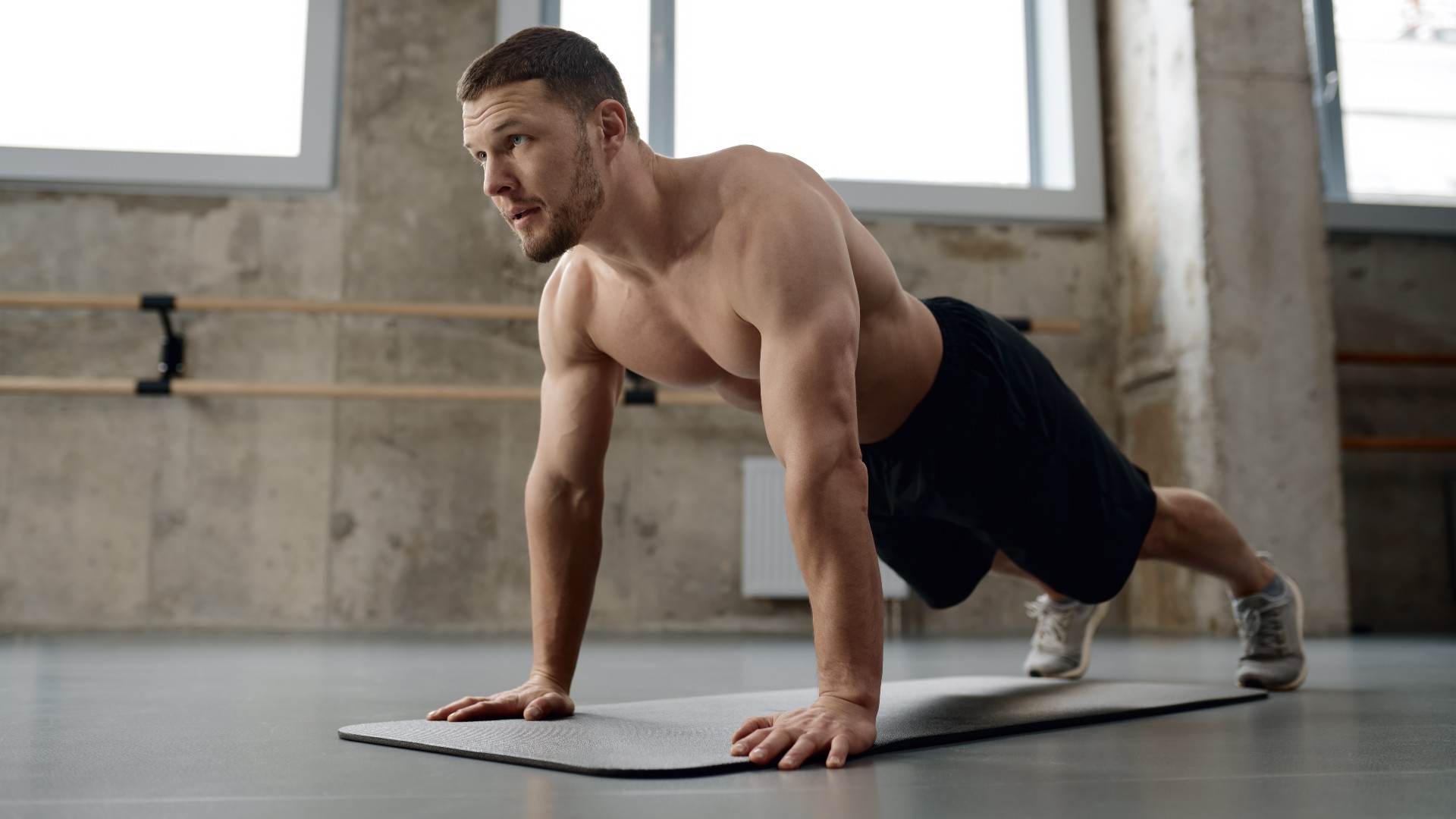
The Russian push-up is the advanced push-up variation I love having in my life right now. I added this exercise to my morning routine each day for one week as a fitness challenge, and here’s what happened.
The first point I’d like to make is that I wouldn’t attempt the Russian push-up unless you already know how to do a standard push-up and can comfortably perform 10-15 reps. I also wouldn’t recommend programming high reps every day for the long term if you’re starting them for the first time — take your time to get your form up to speed, then program with care.
I added 50 reps for seven days using one of the best yoga mats (I swear by the Lululemon Take Form mat) beneath my body. Here’s what I learned.
What happens if I do push-ups every day?
You can safely perform push-ups every day, especially if you have plenty of experience with them. But as a personal trainer, I don’t recommend hundreds of reps for the long haul.
The best way to consider rep count (in this instance) is to work out your maximum number of reps, then work shy of it by 5-15 reps. Just remember, muscle groups need time to recover if you want them to build. If you don’t have any injuries, you’re not pre or post-natal, and you feel comfortable, a short-term high-rep fitness challenge should be safe, but check you can scale according to your ability.
How to do Russian push-ups
If you have shoulder or elbow injuries, check with a qualified personal trainer or physician before undertaking any new exercises.
Here’s how to do the Russian push-up properly:
- Start in a push-up position with your shoulders stacked over your wrists and hips aligned with your shoulders.
- Brace your stomach to engage your core muscles.
- Begin bending your elbows and slowly lower your body toward the floor with your shoulders slightly ahead of your hands.
- Pause, then begin shifting your weight backward and lower your forearms to the floor close to your ribcage.
- Avoid flaring elbows outward and keep them tracking behind you, making sure your hips and thighs don’t drop and your bum stays aligned with your shoulders.
- Lift your elbows again and rock forward, keeping your chest just above the floor.
- Push up into the starting position.
In the forearm position, you'll sit slightly lower to the floor than usual, and as you push-up, try to separate your shoulder blades at the top and push away with your upper back.
I did 50 Russian push-ups every day for one week — here’s what happened
Here's what happened.
Day 1: I scaled
You can scale Russian push-ups in several ways. Two options I used throughout the week included using my knees and positioning my feet on sliders (you could also use a dish towel or similar), which helped facilitate the pushback into the forearm plank but can feel more challenging as you push forward again.
Just be careful if you choose to practice using your knees — it’s a more accessible option that can help you develop the correct movement pattern, but naturally, your bum will lift into the air, which could create an arch in your lower back. Ensure your core is tight and you’re not excessively moving into your lower back.
In terms of reps and sets, I opted for five sets of 10 reps unbroken, which provided just the right amount of intensity.
Days 2 and 3: Boy, these are hard
Russian push-ups combine forearm planks, push-ups, and a forward and backward rocking motion from a low push-up position, so must be performed carefully, meaning form is everything.
I scheduled these reps in the morning and stuck to my regular workout routine in the early evenings (when I prefer to train) so my muscles didn’t feel overworked or tired.
Like regular push-ups, the combo targets your chest, shoulders, triceps and core muscles, and by adding the plank, you’ll also engage other major muscle groups like the glutes, hip flexors, hamstrings, quads and back, including the erector spinae, that hug the spine. My entire body felt torched — I had definitely underestimated the exercise.
Days 4 and 5: I enjoyed the challenge
As the days went on, I found myself reveling in the challenge. I enjoy learning new skills, and in my line of work, I try to meet challenges and constantly evolve my learning as much as possible.
I’ve tapped into Russian push-ups before but never given much time to them, so with 50 reps per day to play with, I could take my time and have some fun with them. I found my technique improved throughout the week, and slowly, I had to look in the mirror less often to check my form.
Sometimes, form slips are almost imperceptible, while others — the bum slightly lifting, hips dropping, the shoulders protracting, or the spine arching, for example — are clearer to spot. If you're unsure, perform your reps in front of a mirror or using a spotter.
Day 6: The forward motion is the hardest to nail
As I reached the final few days of the Russian push-up challenge, I started to reflect on what I liked and disliked about the exercise, having achieved the upper body exercise in volume throughout the week.
Rocking forward while lifting the elbows off the floor is killer on the triceps and shoulders, and I found it by far the toughest phase of the move. It’s tempting to lift the chest and bum, but I stayed close to the mat beneath and shifted forward, not upward. If you prefer using your knees at this point, remember to protect your back and focus on moving fluidly while maintaining core activation.
Day 7: Final verdict
Russian push-ups are taxing on the upper body, for sure. Unlike the simple up-down movement pattern of the humble push-up, this variation increases time under tension — how long your muscles spend active, which can improve muscular endurance and aid muscle growth.
That said, programming daily Russian push-ups alone is unlikely to build muscle definition to rival a bodybuilder. Add rest and recovery to your strength training programs and include a variety of exercises that target different muscle groups. Overloading the muscles helps them grow, but you won’t find growth if you’re injured, so be sensitive around your reps and sets long term, and keep fitness challenges short term.
This is easily the most demanding push-up variation I've tried. My upper body and core muscles were put through the wringer, which I personally enjoyed. Still, I wouldn't choose to do them every day, and while the exercise is fantastic for developing mobility, range of motion and stronger joints, overdoing it could be harmful to the body over time.







